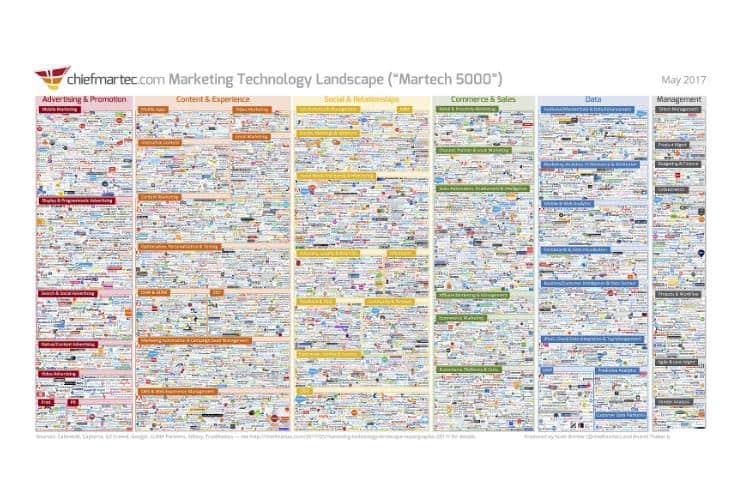According to Gartner, marketing leaders spend 29% of their budget on their Martech stack. That’s nearly a third of the overall budget for just the tools themselves. As companies scale and evolve into enterprises, the tech stack issues compound: on average, an enterprise company is using 91 marketing cloud services.
Does that mean you’ve made a mistake? Paid for a tool you shouldn’t have? Paid for 10 tools you shouldn’t have?! Not necessarily. Marketing technology is constantly evolving, and often at a rapid pace. When you got those tools, it may have been the best move you could have made- but that doesn’t mean it’s still true.
What is Tech Stack Fatigue?
Tech stack fatigue is what happens when your tools are no longer adding the value you paid for. Maybe they don’t all integrate well together. Maybe a few of those tools are relics of previous team leaders, and no one remembers how to use them. Maybe you’re tired of watching your team waste time switching between different logins and programs.
5 Downsides of Tech Stack Fatigue
-
Difficulty IDing customers across platforms
-
Trouble keeping messaging consistent
-
Creates friction between IT and Marketing
-
Added expense without added value
-
Lack of clarity on which tools need upgrading
How Can I Fix Tech Stack Fatigue?
STEP ONE: How to Audit Your Tech Stack
You can’t fix the problem until you know what it is. This article doesn’t go into the specifics of performing an audit, but there are a number of resources and forms you can use to make it easier.
Essentially, you’ll be splitting the tools you have into their core functions (e.g. insight tools, optimisation tools, etc.), in a matrix that also examines them in terms of communication strategy. Once you’ve plugged everything in, it’s a lot easier to see which tools you’re missing, and which you may no longer need. If possible, measure and attribute the revenue that individual tools bring, in order to qualify their efficacy.
STEP TWO: How to Identify Use Cases
Now that you’ve gotten rid of any unnecessary tools, it’s time to find out if your current tools are working well enough, or if you need to upgrade/get new tools. Create a roadmap of where your company is heading. The roadmap is a great place to lay out your long-term goals and how you’ll achieve them, while also ensuring the important short-term goals are taken care of along the way.
With the roadmap as your guide, you can identify which use cases (situations where you could use a tool) you’ll need to achieve your goals. With the use cases selected, it’s time to pick a vendor.
STEP THREE: How to Pick a Martech Vendor
-
Decide what you need
Are you looking for a customer data platform to break data silos and organize your data around the customer? Maybe you’re more interested in an SMS provider that can integrate into your existing communications? Make a list. Make a budget.
-
Compare vendors
There are sites dedicated to this process. G2Crowd is an excellent resource to compare similar vendors. Just type in what you’re looking for and you’re good to go.
-
Set up demos
Often the best way to learn if a tool is right for you is to see it in action. Martech vendors are always happy for the chance to show their product off; go to several demos and make sure you’re getting the tool that fits your stack best. Say no to the slideshow. Ask for an actual demonstration of the product in the room to make sure it works as it should.
Managing Your Tech Stack
You’ve done it. You audited your tech stack, you made a company roadmap and developed use cases, then you saw a few demos, picked vendors for your new tools, and now you’re done!
But no.
The industry is constantly evolving. In order to stay ahead of the game, you need to make sure your tech stack stays relevant. Which means repeating this process every once in a while. You’ll need to ensure that any 3rd party you integrate with is maintaining and updating their connections to your stack. An alternative is to find a solutions provider that can cover the entire tech stack, and can continue to scale and maintain their solutions for your company as you grow.
One of the advantages of Exponea is that every tool is already available within the same platform. Plus, the flexibility of the platform means that if you want to upgrade your tech stack, but keep certain existing tools, you can integrate whichever tools you want, without needing to replace your whole stack.
A Deeper Understanding
Tech Stack Fatigue is just one of the topics Exponea is covering at the next Online Retail Challengers event in London on October 9th. We’ll be reviewing looking at the state of e-commerce today, and where it’s heading, discussing long and short-term e-commerce strategies, and creating a plan for Black Friday 2019. Click the link above if you’d like to attend.
Samuel Kellett, Head of Content at Exponea.com






